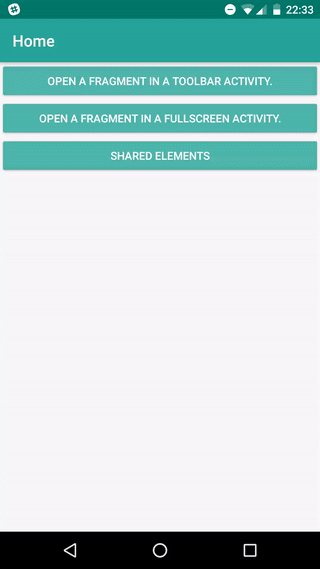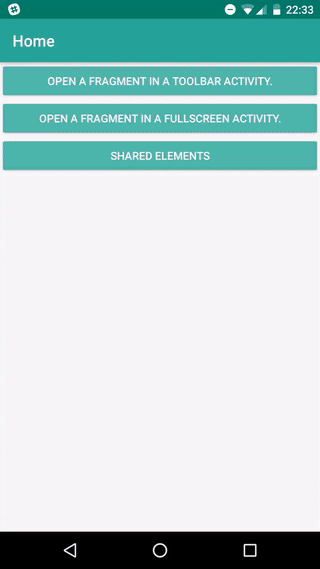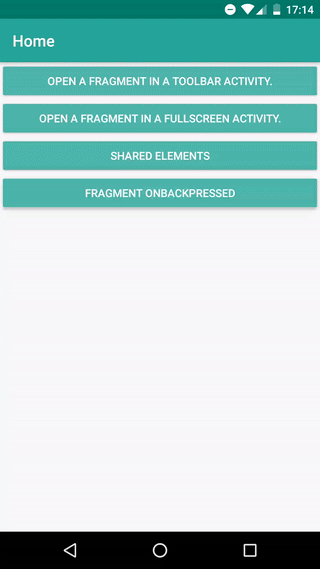Activity Fragment Manager
A library to help android developer working easly with activities and fragments
Motivation
- Accelerate the process and abstract the logic of opening, adding and replacing fragments in an activity;
- Reduce the number of activities declared in the project;
- Get access to
Activity.onBackPressed()inside of the fragments. - Add animated transitions between fragments in an easy way;
- Easy way to work with shared elements;
Download
To use the Activity Fragment Manager, add the compile dependency with the latest version.
Gradle
Add the Activity Fragment Manager to your build.gradle:
dependencies {
compile 'com.massivedisaster:activity-fragment-manager:0.4.3'
}
Maven
In the pom.xml file:
<dependency>
<groupId>com.massivedisaster</groupId>
<artifactId>activity-fragment-manager</artifactId>
<version>0.4.3</version> </dependency>Usage
1. Create your Activity
Create a new activity and extends the AbstractFragmentActivity.
public class ActivityPrimaryTheme extends AbstractFragmentActivity {
// The layout resource you want to find the FrameLayout.
@Override
protected int getLayoutResId() {
return R.layout.activity_primary;
}
// The FrameLayout id you want to inject the fragments.
@Override
protected int getContainerViewId() {
return R.id.frmContainer;
}
}
Create the layout to be used by your AbstractFragmentActivity.
<?xml version="1.0" encoding="utf-8"?> <FrameLayout
xmlns:android="http://schemas.android.com/apk/res/android"
android:id="@+id/frmContainer"
android:layout_width="match_parent"
android:layout_height="match_parent"/>2. Opening, adding or replacing fragments in your AbstractFragmentActivity.
Open a new AbstractFragmentActivity with a fragment.
ActivityFragmentManager.open(getActivity(), ActivityPrimaryTheme.class, FragmentExample.class)
.commit();
Add a new Fragment in the actual AbstractFragmentActivity.
ActivityFragmentManager.add(getActivity(), FragmentExample.class)
.commit();
Replace a new Fragment in the actual AbstractFragmentActivity.
ActivityFragmentManager.replace((AbstractFragmentActivity) getActivity(), FragmentExample.class)
.commit();
3. Default Fragment
You can set a default fragment in you AbstractFragmentActivity. An example, if your AbstractFragmentActivity is started by an external intent you need to define a default fragment.
public class ActivityPrimaryTheme extends AbstractFragmentActivity {
...
@Override
protected Class<? extends Fragment> getDefaultFragment() {
return FragmentSplash.class;
}
}
4. Fragment Transaction Animations.
When you add or replace fragments in the old way you can set a custom animations for the transactions. So, you can set custom animation in easly way using this library.
Single Transaction Animation
If you want to add a single animation only for one transaction you can do this:
ActivityFragmentManager.add(getActivity(), FragmentExample.class)
.setTransactionAnimation(new TransactionAnimation() {
@Override
public int getAnimationEnter() {
return R.anim.enter_from_right;
}
@Override
public int getAnimationExit() {
return R.anim.exit_from_left;
}
@Override
public int getAnimationPopEnter() {
return R.anim.pop_enter;
}
@Override
public int getAnimationPopExit() {
return R.anim.pop_exit;
}
}
)
.commit();
Attention: This only works in transactions between fragments, i.e. add() and replace()
Custom animation for all transactions.
If you want to add a custom animation for all transactions inside of a AbstractFragmentActivity you can override the follow methods:
public class ActivityPrimaryTheme extends AbstractFragmentActivity {
...
@Override
public int getAnimationEnter() {
return R.anim.enter_from_right;
}
@Override
public int getAnimationExit() {
return R.anim.exit_from_left;
}
@Override
public int getAnimationPopEnter() {
return R.anim.pop_enter;
}
@Override
public int getAnimationPopExit() {
return R.anim.pop_exit;
}
}
5. Shared Elements
If you want to make your app beautiful you need to put some cool animation on it! Shared elements are introduce in API 21 and makes the transactions so great and sweet. So, now it's very easy to share elements between fragments or activities. Let's take a look:
Activity A
... .addSharedElement(view, "sharedElement") ... .commit();
Activity B
ViewCompat.setTransitionName(view, "sharedElement");
or
<View
...
android:transitionName="sharedElement" />Attention: Shared elements doesn't work when you use add()! Well if you remove the first fragment it's possible, i.e. a replace :)
6. Custom Intents
Sometimes you want to add more information to the Intent or set some flags. You can use the follow method to open a new AbstractActivityFragment:
Intent intent = ActivityFragmentManager.open(getContext(), ActivityPrimaryTheme.class, FragmentExample.class).getIntent();
intent.setFlag(Intent.FLAG_ACTIVITY_NEW_TASK
| intent.FLAG_ACTIVITY_CLEAR_TASK);
getActivity().startActivity(intent);
7. Fragment#OnBackPressed
Allows to have back pressed events in Fragments.
public class FragmentA extends Fragment implements OnBackPressedListener {
...
@Override
public boolean onBackPressed() {
// Do what you want here! If you return true the activity will not process the OnBackPressed
}
}
Goodies
- You can pass a tag to be applied in the
Fragment. - You can pass
REQUEST_CODEto thestartActivityForResult. - You can
addToBackStack. - You can pass data between fragments using a
Bundle. - You can get acess to the original
FragmentTransaction. - You can use
DataBindingin yourAbstractFragmentActivity, all you need is overrideinitializeDataBinding()and bind the view!
Sample
Sample app can be found in the sample module. Alternatively, you can use dryrun to run the sample.
The Sample app don't require any configuration to interact.


